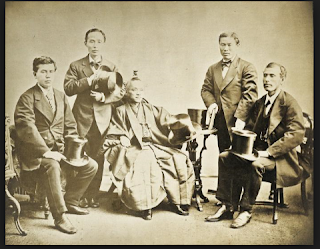Overview of the Meiji Restoration:
Japan began to industrialize throughout the Meiji period. The process of modernizing Japan was started by Meiji officials around the late 1800’s so that Japan could compete with Europe and America. The state apparatus was involved in massive infrastructure buildup which consisted of improving existing roads, improving the railways and embracing policies regarding land that would make future infrastructure improvements smoother. The Japanese government also started up a schooling system modeled after schools in Europe and America for Japanese citizens of school and college age, sent many Japanese youth to the west and invited thousands of Western foreigners to teach STEM and many other subjects in Japan. Many Japanese politicians referred to as the Iwakura Mission journeyed throughout Europe and the United States in 1871 looking for western concepts that would help the Japanese speed up industrialization. The conclusions reached by those who travelled recommended a government backed industrialization policy.
Economic Changes:
The Japanese founded a central bank somewhat like the federal reserve in the year 1877. This bank chose to invest its newly generated revenue from income tax in modernizing the textiles industry which was largely a rural and small scale business in Japan. The Japanese in the late 1880’s then imported new textiles equipment which led to Japan’s production of textiles to skyrocket. In 1886 Japan bought for e.g. its cotton yarn from foreign nations but in the early 1900’s it began to produce enough domestically to reduce imports and then became one of the biggest exporters.
In the year 1872 The nations first railroad connected Tokyo (Edo) to Yokohama. The development of the railways benefited manufacturers who could transport goods at a cheaper price, locate outside of population centers and look for labor who could travel between work and home. The railways also allowed the Japanese to transport natural resources too heavy to transport by other means.
The Meiji restoration was a complete rebuke of the Edo period as the emperor not only embraced a market based economy but embraced western Economic principles. The government while initially backing industrialization eventually privatized much like western nations. They embraced one currency for all of Japan, modernized communications by installing telegraphs in cities of Economic significance. The Merchants, Daimyos and those involved in business came out significantly more prosperous as a result of this era. Feudal Japan was largely abolished and power was unified in the hands of the emperor. Japan emerged as a major industrial power and player in international trade.
Articles to read:
Realizing the Dream
The Impact of the Telegraph on Anglo-Japanese Diplomacy during the Nineteenth Century Jack Nicholls
Videos to watch:
Japan began to industrialize throughout the Meiji period. The process of modernizing Japan was started by Meiji officials around the late 1800’s so that Japan could compete with Europe and America. The state apparatus was involved in massive infrastructure buildup which consisted of improving existing roads, improving the railways and embracing policies regarding land that would make future infrastructure improvements smoother. The Japanese government also started up a schooling system modeled after schools in Europe and America for Japanese citizens of school and college age, sent many Japanese youth to the west and invited thousands of Western foreigners to teach STEM and many other subjects in Japan. Many Japanese politicians referred to as the Iwakura Mission journeyed throughout Europe and the United States in 1871 looking for western concepts that would help the Japanese speed up industrialization. The conclusions reached by those who travelled recommended a government backed industrialization policy.
Politicians on the Iwakura Mission
Economic Changes:
The Japanese founded a central bank somewhat like the federal reserve in the year 1877. This bank chose to invest its newly generated revenue from income tax in modernizing the textiles industry which was largely a rural and small scale business in Japan. The Japanese in the late 1880’s then imported new textiles equipment which led to Japan’s production of textiles to skyrocket. In 1886 Japan bought for e.g. its cotton yarn from foreign nations but in the early 1900’s it began to produce enough domestically to reduce imports and then became one of the biggest exporters.
In the year 1872 The nations first railroad connected Tokyo (Edo) to Yokohama. The development of the railways benefited manufacturers who could transport goods at a cheaper price, locate outside of population centers and look for labor who could travel between work and home. The railways also allowed the Japanese to transport natural resources too heavy to transport by other means.
The Meiji restoration was a complete rebuke of the Edo period as the emperor not only embraced a market based economy but embraced western Economic principles. The government while initially backing industrialization eventually privatized much like western nations. They embraced one currency for all of Japan, modernized communications by installing telegraphs in cities of Economic significance. The Merchants, Daimyos and those involved in business came out significantly more prosperous as a result of this era. Feudal Japan was largely abolished and power was unified in the hands of the emperor. Japan emerged as a major industrial power and player in international trade.
Articles to read:
Realizing the Dream
The Impact of the Telegraph on Anglo-Japanese Diplomacy during the Nineteenth Century Jack Nicholls
Videos to watch:

